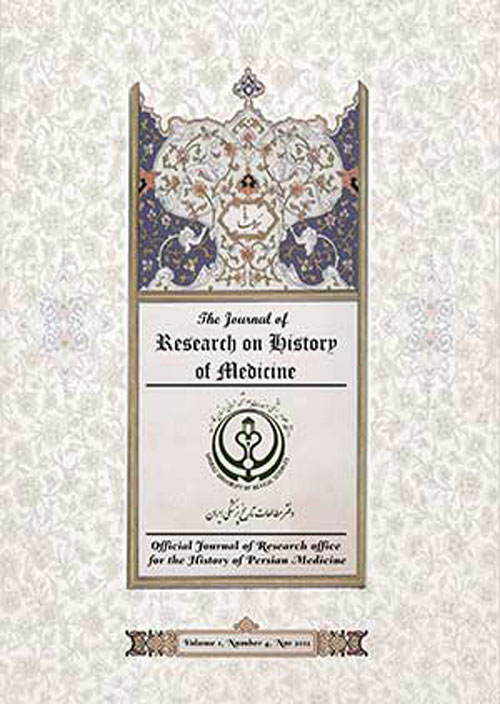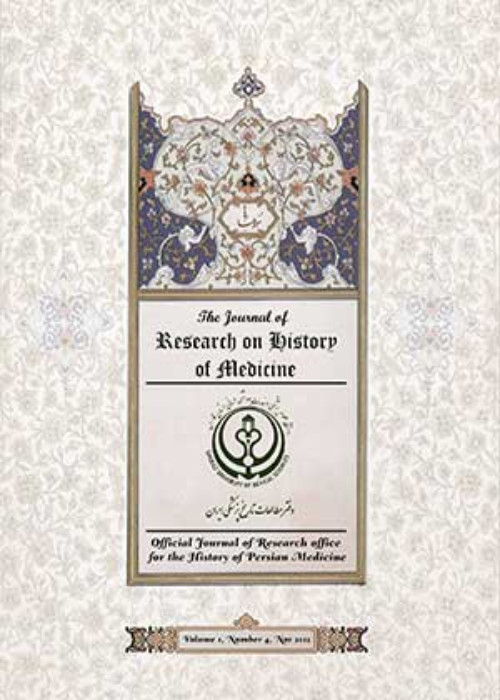فهرست مطالب

Journal of Research on History of Medicine
Volume:10 Issue: 1, Feb 2021
- تاریخ انتشار: 1399/12/24
- تعداد عناوین: 8
-
-
Pages 1-2
-
Pages 3-16One of the most important conditions for the development of medical and pharmacological knowledge in human societies is the availability of drugs. In the past, the most important and widely used types of medications were medicinal herbs. The trade in herbal medicines, imported mainly from India, China, and Southeast Asia, flourished in Fars in the eighth and ninth centuries AH. Examination of the writings of prominent Shirazi physicians and pharmacists, such as Najm al-Din Mahmud ibn Ilyas al-Shirazi, Haji Zain Al-Attar and Muhammad ibn Abdullah Lari, showed that the development of pharmacological knowledge in Fars in the eighth and ninth centuries AH was mainly due to the availability and trade of herbal medicines. The medicine trade was reflected in the poems of Kamal Ghias and Boshaq Atameh Shirazi, the poets of the eighth and ninth centuries AH, as well. This research, based on a descriptive-analytical method and library sources, seeks to find out how the trade of single herbal medicament was in Fars in the eighth and ninth centuries AH and what effects it had on the development of pharmacological knowledge. The findings indicate that the prosperity of the single herbal medicine trade played an important role in the development of the Fars medical school in the mentioned centuries.Keywords: Herbal Medicine Trade, Pharmacological Knowledge, Fars, Eighth, Ninth Centuries AH, Plants Medicinal, India, China
-
Pages 17-24In Iranian medical history, renowned physicians have emerged, some of whom are not well known. Mohammad-Reza Tabib Shirazi is an Iranian physician and chemist, who in the golden age of Iranian history and culture civilization - during the Baburi Empire (Mughal Empire of India) - emigrated to India and there, he created his work called Riyadh Alamgiri. This book is counted as his masterpiece in the field of pharmacology, introducing and identifying simple or compound medications. This article is aimed at introducing the scientific character and work of this physician and pharmacist.Keywords: Mohammad-Reza Tabib-Shirazi, Riyadh Alamgiri, Mughal Empire of India, Aurangzeb, Pharmacists, Physicians, Emigration, Immigration
-
Pages 25-34The Iranian cultural attitude of Samanid epoch, on top of their attention to various sciences, led to the emergence of some scientific works in Persian in this era. Under this circumstance, Al-Akhawayni Bokhari wrote the first medical book in Persian entitled Hidayat Al-Muta’allemin fi Al-Tibb. In his book, in addition to his own experiences, he benefited from the experiences of ancient physicians. This helped him to move the medical knowledge forward; he, in fact, wrote a ground piece of work in this area. This paper investigated the content of this book and revealed that the author was proficient and expert in ancient scientific resources. Taking advantage of these resources and adding his own experiences to them, he wrote a comprehensive medical book in the Islamic era. As such, in addition to various innovations employed in the book, it is shown to be an outstanding work, firstly because the book was written in Persian, known as the first Persian medical book in the Islamic era and secondly because the book took an empirical and deductive approach.Keywords: Islam, Iran, Physicians, Hidayat al-Muta’allemin fi al-Tibb
-
Pages 35-48After the establishment and spread of the Shiite religion, the sanctity of the tombs of Imams and Imamzadehs in the holy shrines of Aliaat, Mashhad, Qom, Rey, etc. increased in the Shiite community of Iran. This issue was very popular among the affluent and the sadat. The desire to be buried next to these tombs turned into a spiritual and social value for these people. However, the transfer of the deceased bodies to the desired location was tough, mainly due to the distance and transportation problems. This article, following the descriptive-analytical method and through conducting interview (oral history), seeks to answer the following questions: 1) what difficulties did Sadat Husseini face in Dehdasht to transfer the body of the deceased to the tomb?2) what measures were taken to overcome the problem? According to the findings of research, this family did their best to transfer the body to the holy shrines to show their deep and sincere beliefs. They put the corpse in dakme (Temporary grave) and while observing religious customs, care was taken to protect the corpse against decomposition. Dakme was not architecturally beautiful and was only used to keep the corpse for a certain period of time.Keywords: Dakme, Temporary grave, Sadat Husseini, The dead, Dehdasht, Religion, Humans, Iran
-
Pages 49-64
In southern India, forming the Deccan Shiite governments (1098-895 AH / 1687-1489 AD), which was simultaneous with the Safavid reign in Iran, resulted in incremental Iranians’ immigration to this region. Among immigrants, Iranian Shiite physicians, due to their high medical knowledge and considerable skill, along with the support of the Shiite rulers, enhanced their status and settled in areas under the control of those governments, contributing to the festive medical production and developments there. The main objective of this research is to investigate the effect of the Iranian Shiite physicians, who migrated to the Deccan region, on the Shiite governments' medical advancements. The research hypothesis is that the Iranian physicians developed medicine by establishing Dar al-Shifa (medical schools and hospitals) and teaching and authoring medical books in Persian. Moreover, upon the invitation and support of the Adil Shahi, Nizam Shahi, and Qutb Shahi Shiite rulers, they were appointed as special physicians in the court, resulting in the flourishing and advancement of medical sciences in those areas. The research employed a descriptive-analytical research method and collected data by library resources.
Keywords: Shiite Physicians, Persian immigrants, Dar al-Shifa, Adil Shahis, Nizam Shahis, Qutb Shahis, Iran, India, Hospitals -
Pages 65-70
Hippocratic treatises are early text of medicine, compiled by several scholars, collectively known as Hippocratic Corpus. For the first times in history, Hippocrates rejects the divine theory of disease and laid-down the foundation of scientific medicine. Diseases were described on natural causes. They proposed humoral theory of diseases. According to this theory, there are four humors in the body. Harmony among these humors constitutes a good health. Age, sex, season, diet and regime affect the production of humors and impart their effect on the condition of body. Various ways were adopted for categorization and classification of diseases, making medical studies easier. In these treatises, diseases were broadly categorized based on age, sex and population distribution. Nomenclature of disease was also based upon the name of diseased organ, dominating symptom, etiology and its resemblance with the thing and phenomenon in outer world. This study is focused on understanding Hippocratic classification and categorization of diseases.
Keywords: Hippocrates, Humors, treatise, Classification


